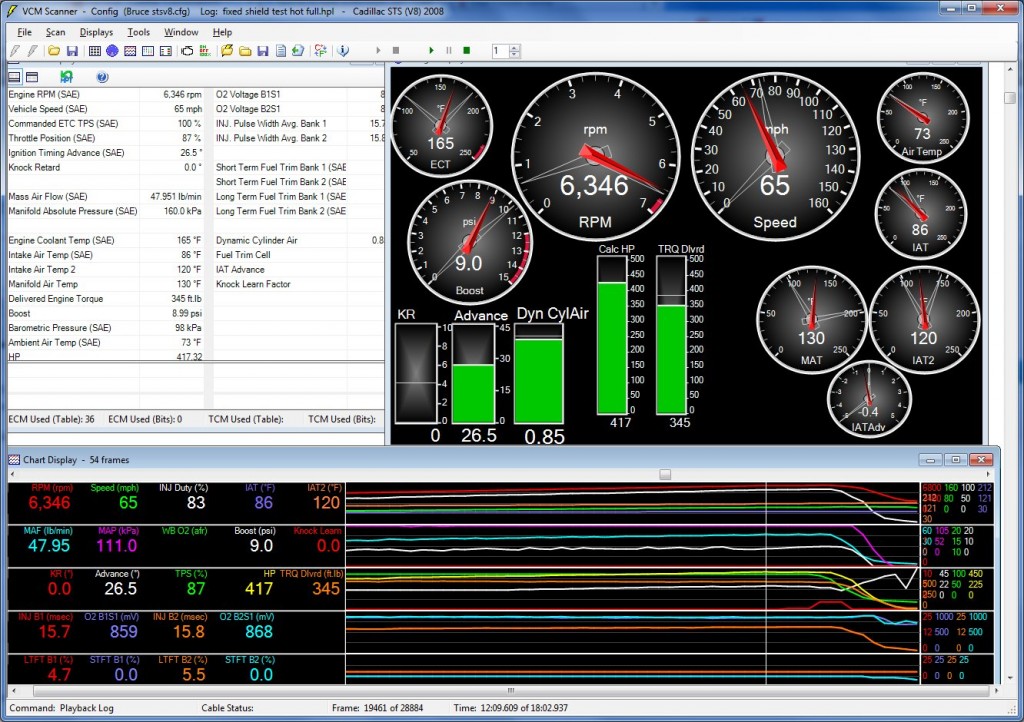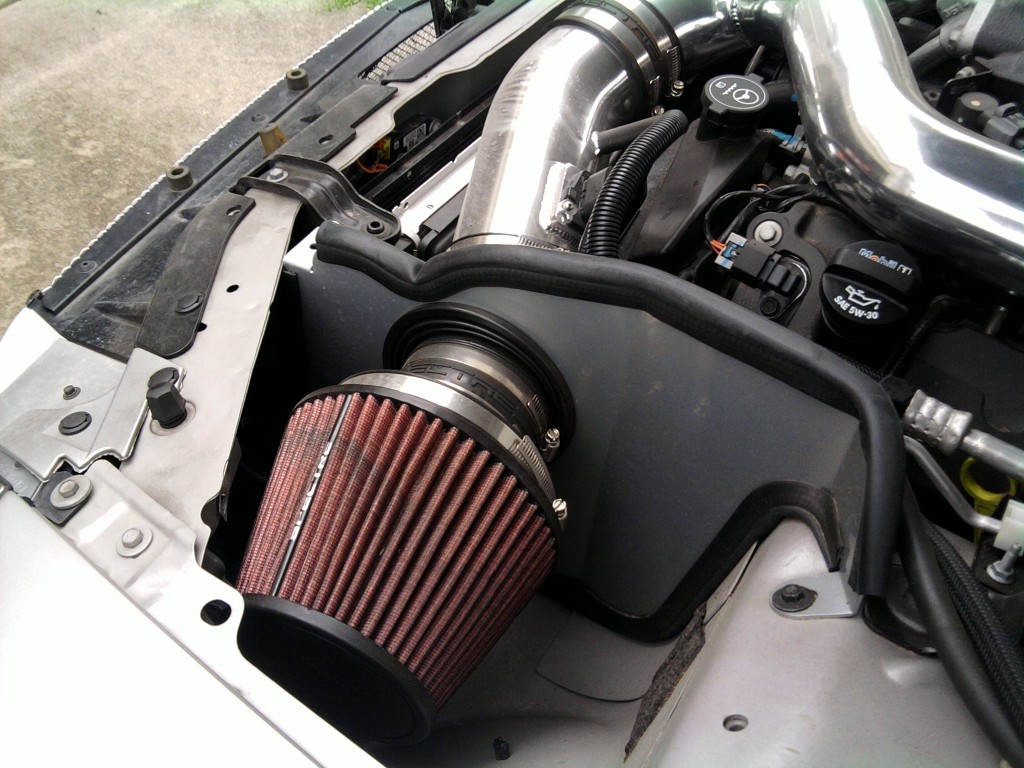I like the Spectre intake for the Cadillac STS-V. However, when we put the intake on we discarded the factory engine covers along the front and side. The Spectre intake includes a barrier to direct air away from the intake filter, but it is not closed at the top.
I was considering building an insulated cover or box, but it is desirable to me to re-use the factory trim pieces. Also, there are some functional air blocks built into the trim that I want to recover use of — example the foam air dam below the center front piece, and at the rear of the driver side piece.
The factory piece that would fit over the driver side won’t fit with the Spectre intake in place, so I trimmed the side piece, and the front center piece, to allow them to fit with the Spectre Intake. I need to get some rubber gasket material to close the gaps, and smooth the edges, but now all the pieces fit.
Even though the V was hot I did a test and data run:

Max calculated power for the test run 415 hp in 2nd gear at 6346 RPM for comparative purposes; max torque 377 lb ft at 3324 RPM.
Unfortunately I only have a heat-soaked mid-day comparison run for today. I attended Church this morning, then worked on trimming pieces, then did a test run.
| Baseline from August 2011 | ||||||
| MPH | (Temps in Deg Fahrenheit) | |||||
| Deltas | Item | 0 | 30 | 45 | 60 | Deltas |
| Ambient | 90 | 90 | 90 | 90 | 0 | |
| 23 | IAT1 | 113 | 117 | 113 | 106 | -7 |
| 5 | IAT2 | 118 | 120 | 127 | 135 | 17 |
| 2 | MAT | 120 | 121 | 136 | 169 | 49 |
| Trimmed Trim Mar 2012 | 75F | |||||
| Deltas | MPH | (Temps in Deg Fahrenheit) | ||||
| Item | 0 | 30 | 45 | 60 | Deltas | |
| Ambient | 75 | 75 | 75 | 75 | 0 | |
| 16 | IAT1 | 91 | 93 | 93 | 91 | 0 |
| 33 | IAT2 | 124 | 122 | 129 | 136 | 12 |
| -2 | MAT | 122 | 121 | 134 | 163 | 41 |
There is a lot to read and try to analyze here, but let’s piece it together.
First, today is cooler than back in August, 75F instead of 90F. However, my STS-V is heat-soaked today and wasn’t back in August.
IAT1 is 16F above Ambient now and was 23F back in August. That is what the trim is supposed to help with, so good. In August the 0-60 run itself cooled the IAT1, while it did not today.
IAT2 was only 2F above IAT1 in August (morning run, not heat soaked); today it was 33F above (heat-soaked). In August the IAT2 gained 17F during the 0-60 run; today 12F.
MAT in August gained 49F on the run; today 41F.
I am cautiously considering replacement of the trim beneficial — did result in lower delta temps. I would like to have a non-heat-soaked current run to compare for apples to apples however. There are still some gaps in the trim fit that will benefit from some gasket material along the edges.




I find this all intriguing for several reasons: first, making the blower seals for nitro drag cars I get to view some of the tuning info and, like the fuel cars the STS-V deals with most of the same issues.
Air is key and I noticed on your ‘cold’ run that the improvement was noticed between 50-60mph. In a fuel car we see differences from air temp/density very quickly and, the STS-V follows suit in the air improvement is evidenced at what would be about half track in the quarter mile. This almost mimics the fuel car, they see differences in air faster for obvious reasons. All blown cars, street or race, are at the mercy of air temp and air density.
I am having Jeremy from Fasterproms do my STS-V next Monday and I will let you know if I discover anything interesting. Anyone may feel free to contact me in the matter of what I discover via the tuning process at olddog@stbarinc.com.
Good write up!!
I hope you’ll share the before/after results of you STS-V tuning session. I love learning more about the details of the Vs and what works on different examples. I am trying to decide between having mine professionally tuned and getting a wide-band O2 installed and trying to dial it in myself.
I broke down and put it on the Dynojet 248 and ALL is stone stock – just the tune with NO bolt ons etc. In two pulls it made 384 and 379rwhp both SAW corrected.
Jeremy does use the wide band in the tail pipe too to just double check when the unit was data logged. Had I let him be more aggressive with the trans and the total torque applied I am told the #’s would have been better. I am satisfied and that is what is important to me.